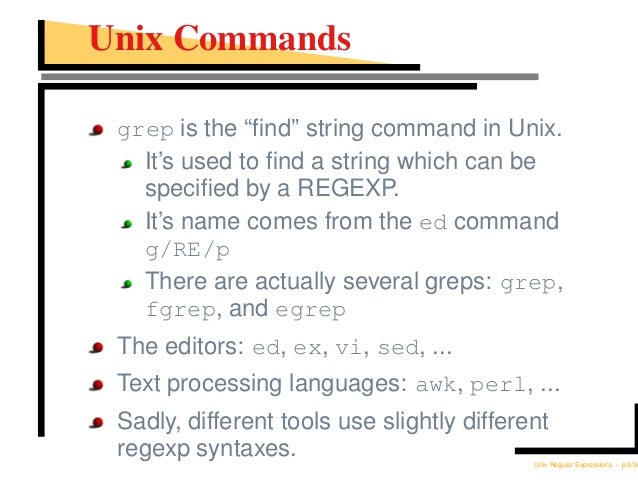

That is, grep knows where the ends of the lines are, but sees the input as one big line. Perl guru Damian Conway states that Raku (i.e. Explanation: -P activate perl-regexp for grep (a powerful extension of regular expressions) -z Treat the input as a set of lines, each terminated by a zero byte (the ASCII NUL character) instead of a newline. The second line using %% does the same-but also allows a trailing comma. The first line using % detects matches wherein a comma separator is interposed between the pattern to the left. 'modified quantifier') that can be used to solve common regex problems.
#LINUX GREP REGEX CODE#
Now you might be asking yourself, "So what? It looks just like Perl5." That's because the code above is almost a direct translation of Perl5/PCRE. Reading the above regex literally, it says: 'Find one-or-more digits followed by an optional (zero-or-one) dash-one-or-more digits, followed by either a comma or end-of-line ( $$), the entire preceding pattern repeated one-or-more times.' Secondly, modifiers of the basic regex engine like :global acquire a leading colon and appear at the head of the m/./ match construct. Using Raku (formerly known as Perl_6) raku -ne '.put if m:g/^^ ?] ]+ $$/ 'Īn advantage of using Raku is whitespace tolerance within the matcher. It may be written as an (GNU) extended regex: grep -E '^((+(-+)?(,|$))+)$'Īs a Basic Regular Expression (BRE): grep '^\(\(\įor (j = 1 j 2))next for(j=1 j a) next All must be matched, and anything that is not matched gets rejected. That leaves no optional interpretations to the regex machine. If the leading comma should be rejected, use: ^((+(-+)?(,|$))+)$ You may test and edit the PCRE regex in this site It is a very good idea to anchor the regex to the beginning and end of the text tested: ^((^|,)(+(-+)?(,|$))+)$ Then, each of those numbers: 3 (or number ranges: 4-9) should be followed by a comma, (several times): (+(-+)?,)+Įxcept that the last comma might be missing: (+(-+)?(,|$))+Īnd, if required, a leading comma might be present: (^|,)(+(-+)?(,|$))+ When using basic regular expressions, the meta-characters are interpreted as. Always enclose the regular expression in single quotes to avoid the interpretation and expansion of the meta-characters by the shell.

Where the ? makes the dash-number sequence optional. The syntax for searching multiple patterns using the grep basic regular expressions is as follows: grep 'pattern1\pattern2' file. Then, a run of digits would be matched by +.Īfter a number (1 or 3 or 26) ther could be a dash '-' followed by one or several digits ( a number again ): +(-+)? Then you would need to write: to be precise. It could match Devanagari numerals, for example. The most basic element to match is a digit, lets assume that, or the simpler \d in PCRE, is a correct regex for a English (ASCII) digit.
#LINUX GREP REGEX FULL#
The full pcre that will match the strings you listed (and those that start with a ,) might be: grep -P '^(+(-+)?(,|$))+$'


 0 kommentar(er)
0 kommentar(er)
